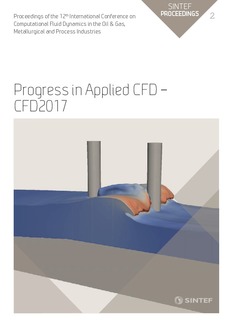| dc.contributor.author | Schneiderbauer, Simon | |
| dc.contributor.author | Kinaci, Mustafa E. | |
| dc.contributor.author | Hauzenberger, Franz | |
| dc.contributor.author | Pirker, Stefan | |
| dc.date.accessioned | 2017-11-14T06:46:31Z | |
| dc.date.available | 2017-11-14T06:46:31Z | |
| dc.date.issued | 2017 | |
| dc.identifier.isbn | 978-82-536-1544-8 | |
| dc.identifier.issn | 2387-4295 | |
| dc.identifier.uri | http://hdl.handle.net/11250/2466017 | |
| dc.description.abstract | Fluidized bed and moving bed reactors are one of the most important technologies in several branches of process industry. Especially, it is known since decades that iron can be reduced rapidly and efficiently from iron carrier materials using such. The primary energy sources and reducing agents are natural gas, coal, coke, pulverized coal, which are finally released as CO2 and in a lesser extent as H2O to the environment. Iron reduction consumes about 70% of the energy during steelmaking therefore offering potential in energy and CO2 savings. Due to the limited accessibility for measurements, simulation methods have become one of the most important tools for optimizing the iron making processes. While the two-fluid model (Schneiderbauer et al., 2012) would be a good candidate to attack the simulation of large-scale multi-phase processes it lacks from a proper representation of the particle size distribution and the related physical phenomena. This, in turn, gives rise to particle-based approaches, such as the coupling between CFD and DEM methods, which can easily handle particle segregation, particle growth and particle mixing. Furthermore, chemical reactions can be evaluated per particle and it is not required to transfer these reactions to a continuum representation. However, CFD-DEM approaches require an appropriate coarse-graining to considerably reduce their computational demands. We, therefore, present a generalization of the Lagrangian-Eulerian hybrid model for the numerical assessment of reacting poly-disperse gas-solid flows (Schneiderbauer et al., 2016b) to fluidized beds used for iron ore reduction. The main idea of such a modeling strategy is to use a combination of a Lagrangian discrete phase model (DPM) and a coarse-grained two-fluid model (TFM) to take advantage of the benefits of those two different formulations. On the one hand, the DPM model unveils additional information such as the local particle size distribution, which is not covered by TFM. On the other hand, the TFM solution deflects the DPM trajectories due to the inter-particle stresses. This hybrid approach further enables the efficient evaluation of the gas-solid phase reduction of iron ore at a particle level using DPM. The predictive capability and numerical efficiency of this reactive hybrid modeling approach is demonstrated in the case of a lab-scale fluidized bed. The results show that the model is able to correctly predict fractional reduction of the iron ore. The results further give a closer insight about the temperatures and reaction gas consumption due to the reduction process. | nb_NO |
| dc.description.sponsorship | The authors want to acknowledge the support of Dr. Christoph Klaus-Nietrost, who provided the c-code for the reduction model developed during his PhD work "Development of Conversion Models for Iron-Carriers and Additives within a Melter-Gasifier or Blast Furnace" (Institute for Energy Systems and Thermodynamics, TU Vienna, 2016). This work was funded by the Christian-Doppler Research Association, the Austrian FederalMinistry of Economy, Family and Youth, and the Austrian National Foundation for Research, Technology and Development. The author also wants to acknowledge the financial support from the K1MET center for metallurgical research in Austria (www.k1-met.com). | nb_NO |
| dc.language.iso | eng | nb_NO |
| dc.publisher | SINTEF Academic Press | nb_NO |
| dc.relation.ispartof | Proceedings of the 12th International Conference on Computational Fluid Dynamics in the Oil & Gas, Metallurgical and Process Industries | |
| dc.relation.ispartofseries | SINTEF Proceedings;2 | |
| dc.subject | Fluidized bed | nb_NO |
| dc.subject | Iron ore reduction | nb_NO |
| dc.subject | Two-fluid model | nb_NO |
| dc.title | A Lagrangian‐Eulerian hybrid model for the simulation of direct reduction of iron ore in fluidized beds | nb_NO |
| dc.type | Chapter | nb_NO |
| dc.description.version | publishedVersion | nb_NO |
| dc.rights.holder | © SINTEF Academic Press | nb_NO |
| dc.subject.nsi | VDP::Technology: 500 | nb_NO |
